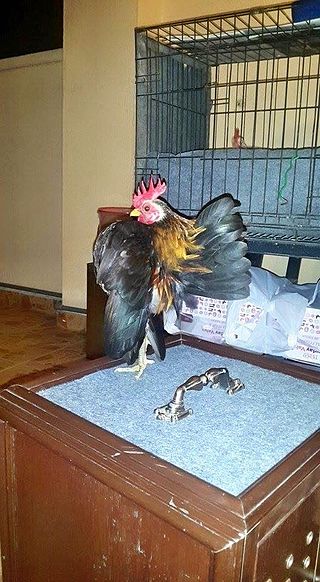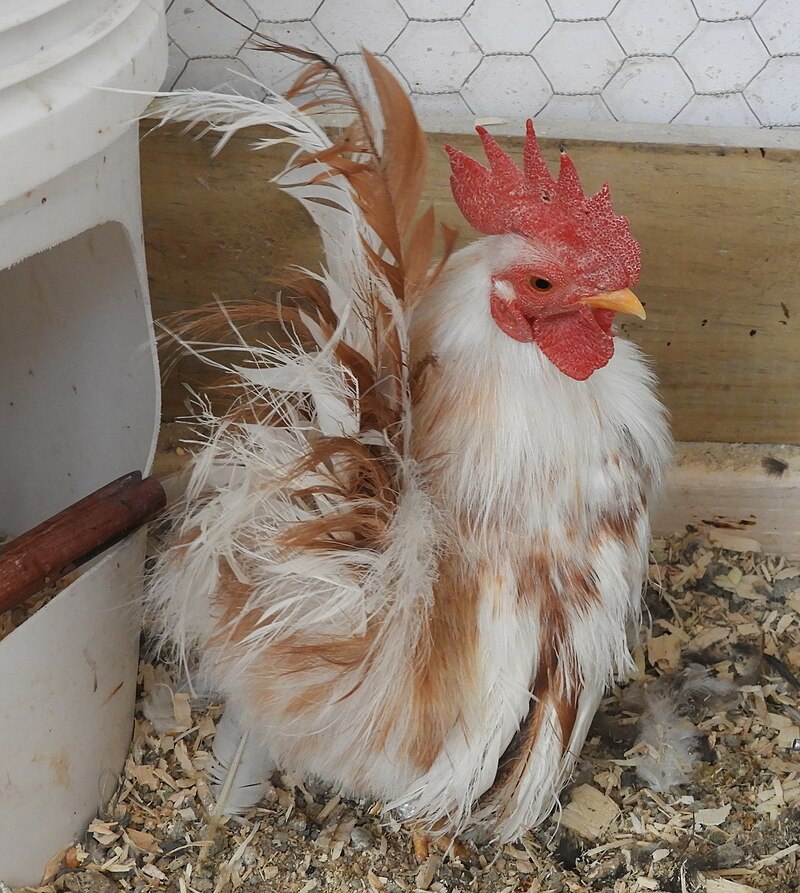Complete Guide on Raising the Serama Chicken Breed

The Serama chicken is a relatively new but extremely fascinating breed. These little birds are known for their distinct appearance and their amiable, gentle demeanor.
When taken together, these features make the Serama a top pick for serious backyard poultry farmers.
This bantam breed, also called the Malaysian Serama, has only existed for the past fifty years. In Malaysia, seramas are more commonly referred to as ayam katik (pygmy chickens) or ayam cantik (pretty chickens.)
One of the most popular small chicken breeds in the world is the Serama chicken. The Serama breed of chicken is not only the tiniest recognized chicken in the world, but also one of the most expensive.
The Serama chicken breed has been very popular in Singapore for many years, despite the fact that it is relatively new to the West. Since the chicken has no larger designated counterpart, the Serama is the only true bantam breed in the world.
Although the Serama breed has won over shepherds all over the world, there are still relatively few of them.
Serama Chickens: A Brief History

Malaysia’s province of Kelantan is home to the Serama breed, which is the most popular domestic chicken in the country.
Although there is no concrete evidence to support these claims, many theories place the breed’s origins in the 1600s. Wee Yean Een was credited with starting the current Seramas dynasty in the 1970s.
Een started a breeding program for Serama that involved crossing Ayam Kapans with both the Japanese bantam and Silkies breeds. The Serama breed is named after Wee Yean Een, who did so in honor of King Rama, a Thai monarch.
Jerry Schenxnayder was the first person to bring the Serama breed to the United States in 2000.
When the Asian Bird Flu pandemic hit a few years later, the United States banned all imports of birds, so his import of the Serama breed was nothing short of a remarkable feat.
The Serama breed of birds was nearly wiped out by the same Asian flu pandemic, but these little birds proved to be exceptionally hardy and resilient and were able to recover successfully.
In order to create specific rules and regulations for the breed, Schexnayder established the Serama Council of North America. Serama chickens, a hybrid breed from Malaysia and North America, were first imported into the UK around 2004.
The original Serama chicken breed was developed through selective breeding of Malaysian bantams with Japanese bantams.

In contrast to other breeds, seramas won’t breed to a single color, so they come in a wide range of more than 2000 colors. They can appear frizzled or silky in addition to the smooth feathered variety.
The chickens’ final height shouldn’t be more than ten inches, but they may be larger or smaller when they hatch.
In its country of origin, no official guidelines have been established for the breed. They do, however, have a standard scoring and judging guide for competitions in Malaysia now.
Many breeders breed exclusively to a certain “style,” or type, but many also keep multiple “styles” in their collections.
Breeders often give these styles names to indicate the champion’s family tree (e.g., Husin, Mat Awang), but the names can also refer to the chickens’ general appearance, personality traits, or behavior (e.g. slim, submarine, and dragon).
Thus, Malaysia is home to a wide range of cultures, but there is a common motif of a courageous little chicken playing up an image of a fearless warrior or toy soldier.
The size, temperament, behavior, and general shape of the bird are the most notable features. The contestants face off against one another in open table top competitions (also known as “beauty contests”) judged by a panel of experts.
The winning birds could walk away with a sizeable sum of cash.
Appearance of the Serama Chickens

The Serama chicken breed is characterized by its diminutive size. They can be as short as six inches or as tall as just under ten inches.
They carry themselves in an upright “V” shape, and they even carry their tail feathers upright.
A full breast is carried by the Serama, who has a muscular build. When compared to their bodies, Seramas typically have large wings, and they hold their wings downward, almost touching the ground.
To accommodate their full and muscular body frame, the Serama’s legs can be either medium or long, straight, and spaced widely apart.
They give off the impression of being constantly on guard or alert. The Serama breed has been called everything from “toy soldier” to “fearless warrior” because of their appearance.
Due to their small head, the Serama chicken breed tends to carry it back with an upright posture. The comb and wattles of a Serama are both red. However, their earlobes can be either red or white, and their eyes are a bright bay red.
The male Serama chickens have much larger wattles and combs than the females. The Serama chicken breed has a small back, leaving only a small gap between its body and its tail feathers.
The Serama stand tall, have a full chest, hold their tail feathers vertically, close to the body, and tight to the ground, and their wings are held vertically, nearly touching the ground.
Because they look so much like humans, people in Malaysia refer to them as “archangel chickens” and “brave warriors.”
The world’s tiniest chickens come from this breed. The average weight of a serama is less than 500 grams (18 ounces), but birds weighing as little as 250 grams (8.8 ounces) have been bred in their native Malaysia.
Though physical stature isn’t the only thing that makes someone a Serama. Without the Serama “type,” a small chicken is just another small bantam, not a Serama.
Personality and Demeanor

In spite of their seemingly aggressive demeanor, seramas are actually quite docile and easy to work with. The bird should pose readily and when viewed from the side should create a vase like or wide ‘V’ shape outline.
They walk proudly with their head thrown back to expose a broad chest, strut around with their legs in the air, and in some styles, their necks and heads vibrate like a pigeon’s.
Body
The breasts are carried high and full and the body is well muscled. The overall outline is elliptical, with a sharper point at the end of the tail. Reduce the length of the body.
Wings
The wings of a serama are relatively large in comparison to the rest of the body, and it is proper for them to be held vertically so that they just touch the floor and reveal the bottoms of the feet.
The bird’s shoulders must be raised. Long and moderately broad, the primary branches are longer than the secondary branches.

Tail
The bird’s tail is thick and carried high, pointing skyward, and is held tightly against its body so that there is no separation between them. The sickle’s feathers are relatively upright and spearlike in appearance.
This feather should be at least an inch longer than the others on the tail, but ideally it shouldn’t extend more than a couple of inches above the bird’s head.
When at attention, the remaining tail feathers shouldn’t reach any higher than the comb. You want your main tail feathers to be wide and overlap in a tidy fashion. The tail should be wide open, forming a 45-degree ‘V’ when viewed from behind.
Head
The head needs to be small and held far back, above the level of the feet and at an angle of more than ninety degrees from the body. One comb, preferably with at least five serrations, should be small to medium in size.
The comb should be straight and smooth with a tendency toward the flyaway type, with no folds or other deformities. Wattles are meant to supplement the comb; smaller is better, and they shouldn’t have any folds or wrinkles.
Legs and Feet
The legs are of a moderate to generous length, are perfectly straight, and are spaced far enough apart to accommodate a thick, muscular frame. The foundations should be solid and sturdy.
Muscular, medium-length thighs are ideal, as are thicker than average lower legs. They must avoid coming across as weak and flimsy.
Color and Feathers
Seramas, like many other Asiatic breeds, are not color bred in their country of origin. In Malaysia, it’s illegal to own a bird that doesn’t have normal feathers. Feathers should be short and pinned close to the body.
Americans and Europeans alike can accept birds with silken plumage. Some birds imported from Malaysia were thought to carry the silkied gene.
Crossing with different breeds has also resulted in the introduction of new mutations (such as frizzled, rumpless, and booted bantams) in the United States and some parts of Europe. They come in a rainbow of colors and shapes.
Breed Standards for Serama Chickens

The Serama chicken breed has different standards depending on where you are in the world (Malaysia, US, or UK).
For Westerners, the Malaysian standard is the most perplexing. This is typically due to the fact that the breed is categorized according to its shape, such as slim, apple, ball, dragon, etc.
The American standard was written with the combination of slim and apple in an effort to make this more understandable for those who are not as familiar with the types.
White was chosen as the designated accepted color when the Serama breed was formally accepted into the American Poultry Association in 2011.
Then, in 2018, black became socially acceptable. The Serama breed was formally recognized in 2008 by the Poultry Club of Great Britain.
The Serama chicken breed can be found in the following sizes and weights, according to the standards:
- Micro – Males allowed up to 13 ounces and females up to 8 ounces
- A Class – Males allowed under 13 ounces and females under 12 ounces
- B Class – Males allowed under 16 ounces and females under 15 ounces
- C Class – Males allowed under 19 ounces and females under 19 ounces.
Any Seramas that does not meet the aforementioned weight and size requirements is rejected.
There have been some flock keepers that have successfully bred Seramas smaller than the micro standard, but unfortunately, this breeding comes at a high price to the bird.
For those smaller-sized hens, Seramas have difficulty hatching and raising their chicks. For instance, maintaining a successful hatch rate is much more difficult for class A birds.
Temperament of Serama Chickens

Seramas are a kind little chicken with a lot of personality in a small package. These birds, unlike the majority of other breeds, enjoy moving with their flock keeper.
Because of the Seramas’ size, some flock keepers choose to keep them with their larger flock members.
Serama chickens can withstand extremes of both hot and cold temperatures with ease. The younger chicks, in particular, require a draft-free environment with temperatures above 40 degrees Fahrenheit.
Seramas do well in captivity despite their love of foraging. The best environment for seramas is an aviary with a grassy floor. Wet and muddy conditions are not good for the breed.
Seramas will occasionally act in an assertive manner. They are a friendly and placid breed that is simple to handle, so they make excellent house pets.
It is recommended that flock keepers separate the roosters if they discover that there are multiple roosters present. When the proper rooster-to-hen ratio is not maintained, Serama roosters are known to be extremely aggressive toward one another.
Broodiness and Serama Chickens Egg Production
Small eggs are laid by seramas because they are such tiny birds. It would take five Serama eggs to equal the volume and nutritional value of a single premium supermarket egg.
It is common knowledge that seramas lay between three and five eggs per week. While the frequency of egg-laying varies greatly between breeds, on average a hen can produce four tiny eggs per week.
Around 180-200 eggs are laid each year at this weekly rate. The eggshells of Seramas will range in color from white to dark brown and all shades in between.
Seramas lay eggs all year long, but the months of November through February are typically when they are most fertile. However, birds raised in colder climates do not exhibit this level of fertility on average.
Both broody and wonderful mothers to their young, Serama chicken hens are renowned for their excellent parenting abilities. Because of their diminutive stature, it is best to avoid giving them more than four to six eggs to brood at once.
Compared to other chicken breeds, the Serama chicken breed has a quicker hatching period for its young.
The incubation time for Seramas usually runs around 19-20 days total. Only 15–17 days are required for the hatching of the micro strain of the breed.
Sadly, like their Japanese bantam ancestors, the Serama chicken breed has a fatal gene. A quarter of the hen’s eggs will not hatch if this gene is present.
The chick can’t get into the right position for hatching because of how quickly its legs develop.
By 16 to 18 weeks of age, Serama chicks will be fully grown hens, making them significantly earlier layers than other breeds. The hens won’t reach full maturity, though, for another 15–18 months.
Breeding Serama Chickens

The Serama chicken is very similar to other types of bantams. The entire process from egg-laying to hatching takes about 19 days. Young chicks are more vulnerable to the effects of low temperatures than larger birds.
About 16–18 weeks after hatching, the chicks will have matured enough to start laying eggs on their own.
A notable American breeder, Brian Sparks of Wisconsin, is an advocate of the Malaysian breeding method. Authentic Malaysian birds have a powerful type, and he was able to recreate that.
The homeland and the best breeders of the Serama heard the news. Malaysian media outlets took an interest in his work, and they ran stories about his achievements.
Serama Chickens’ Known Problems
Other than the fact that some Seramas have trouble adjusting to colder climates, the breed is not known to have any specific health issues.
In contrast to other breeds, which typically molt once a year, the Serama is a breed that will molt continuously. They do not undergo a full molt. They simply have a propensity for shedding feathers at inopportune moments.
Are Serama Chickens A Good Choice for You?
The Serama chicken is a favorite among flock owners in addition to being an exceptionally beautiful small breed. Due to their small size, they are ideal for people who have limited space but still want a pet chicken.
The Serama chicken is typically regarded as a decorative or even show bird. They are very social with their flock raisers because they love people.
Serama chickens are known to be much quieter than the hens of other breeds and enjoy being held. Even the crow of Serama roosters is softer and more squeaky than those of other breeds.
As therapy birds, serama chickens are thought to be the best option.

Due to their small size, two to three birds can be safely housed in an indoor small aviary or pen if there is a problem or issue with predators.
Although the Serama breed excels at laying eggs, the eggs are small, so you should prepare for more than one at breakfast each morning.
Seramas are wonderful pets and are great with young children. The Serama breed has an average lifespan of seven years, but some have lived as long as ten.
The Serama is an excellent breed if you want to keep feed costs to a minimum. These tiny birds consume about a pound of food per month on average.
Seramas require a diet of crumbles or mash because pellets are too large for them to eat.
Serama chicks, like other chicks, require crumble or mash as a food source, and a quail-specific waterer is required to prevent them from falling in and drowning.
Serama Chickens Summary
The Serama breed is unquestionably the best option if you’re looking for an indoor pet. They’re friendly, smart, and even a little talkative, and they thrive in cramped quarters.
If you’d rather keep seramas outside, you can do so as long as you secure their run and coop from predators. Additionally, it is crucial that their run area is kept dry because they do not perform well in muddy or wet conditions.
References:
- Henderson, Jennifer (March 30, 2009). “Malaysia’s mini-chickens big it up after flu scare”. Reuters.
- Ekarius, Carol (2007). Storey’s Illustrated Guide to Poultry Breeds. Storey Publishing. ISBN 978-1-58017-667-5.
- Wright, Carrie (2009). An Introduction to the Serama Bantam. Seeright Publishing. ISBN 978-0-9562255-0-4.
- “Rela Berhabis Duit Kerana Minat Ayam Serama”. Department of Veterinary Services, Perak, Malaysia.
- “American Serama Association”.
- “Serama Council of North America”.
Related posts:
10 Amazing Ways To Prevent Chicken Mites and Lice
7 Amazing Reasons to Raise Padovana Chickens
10 Amazing Reasons to Raise Polish Chickens
6 Amazing Breeds of Chinese Chickens
10 Amazing Easy to Follow Steps How to Make a Poultry Farm Business Plan
10 Stunning Scientific Reasons To Feed Chicken Scratch to Your Flock


